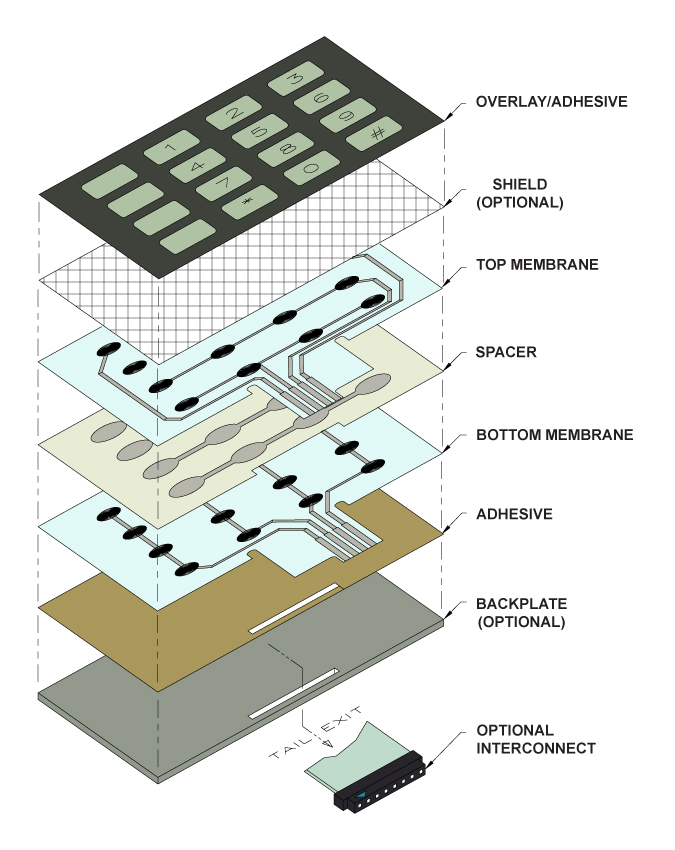Discover Exactly How a Membrane Switch Enhances Durability and Functionality in Tools
Discover Exactly How a Membrane Switch Enhances Durability and Functionality in Tools
Blog Article
Just How Membrane Switches Contribute to the Resilience of Electronic Control Panels
Membrane buttons play an essential role in improving the longevity of digital control panels, mainly via their multi-layered construction which supplies reliable defense versus environmental elements such as moisture and dust. The absence of moving parts substantially minimizes the chance of mechanical failures, making membrane switches over ideal for demanding applications.
Meaning of Membrane Layer Buttons

Membrane switches are made to be thin and light-weight, making them suitable for applications where space is limited. They can be made in different forms, dimensions, and shades, offering versatility in layout that satisfies visual and useful needs. In addition, membrane switches can incorporate various technologies, such as responsive feedback and LED indications, enhancing user experience.
As a result of their building and construction, membrane layer switches are typically resistant to dust, wetness, and basic wear, adding to their toughness popular atmospheres. Their smooth style not just promotes simple cleansing yet additionally decreases the risk of mechanical failure, making them a recommended choice for makers looking for dependable interface in their electronic control panels.
Protection Against Environmental Elements
The layout of membrane layer switches naturally supplies a level of security versus different environmental factors, which is essential for preserving capability in challenging conditions - Membrane Switch. These switches are typically built with layers of flexible materials that shield inner elements from moisture, dirt, and impurities. By enveloping the wiring, membrane changes minimize the risk of short circuits and corrosion, which can substantially impair efficiency
Moreover, making use of robust adhesives and sealers during production enhances their resistance to ecological obstacles. Membrane switches can endure exposure to chemicals and solvents, making them appropriate for markets such as food handling and health care, where health and tidiness are critical. Their smooth surface area style likewise prevents the build-up of dust and microorganisms, facilitating easier cleansing and upkeep.
Temperature changes are an additional ecological issue, and membrane switches are crafted to work properly across a broad variety of temperatures (Membrane Switch). This flexibility ensures that control board remain operational in different settings, from commercial atmospheres to customer electronics
Influence on Individual Interaction
Customer interaction with digital control panels is dramatically affected by the design and performance of membrane layer buttons. These switches offer look at here a responsive user interface that boosts the general individual experience, enabling intuitive navigation and control. Their receptive nature guarantees that users obtain immediate feedback upon activation, which is essential for tasks requiring accuracy and performance.
In addition, the smooth surface of membrane layer changes facilitates simple cleansing and upkeep, promoting user confidence in the dependability of the interface. This tidiness is especially vital in environments where hygiene is critical, such as clinical or food processing setups. Additionally, the compact and light-weight design of membrane layer switches over adds to the visual appeal of control panels, encouraging individual involvement with a modern and smooth look.
Moreover, the assimilation of aesthetic elements, such as printed symbols and backlighting, aids individuals swiftly determine features, minimizing the discovering contour connected with brand-new equipment. Consequently, customers can run gadgets more effectively, causing raised performance and satisfaction. In summary, membrane switches play a pivotal role in improving individual communication by integrating functionality, aesthetics, and ease of use, eventually causing improved functional efficiency.
Design Adaptability and Personalization
Style flexibility and personalization are essential elements of membrane switches, making it possible for suppliers to tailor digital control board to specific applications and individual requirements. This adaptability enables for the combination of different style aspects, such as colors, graphics, and textures, which can boost the visual appeal and individual involvement of the control panel.
Membrane buttons can be tailored in size and shape, suiting a wide variety of tools and applications, from commercial equipment to consumer electronics. This flexibility makes sure that suppliers can develop intuitive interfaces that line up with individual expectations and functional requirements. Furthermore, the capacity to include unique functions such as backlighting or responsive comments further enhances usability, permitting for a more interactive experience.
Moreover, the manufacturing procedure for membrane layer changes supports the quick prototyping of layouts, making it possible for producers to iterate and refine their principles promptly. This capability not only speeds up the development timeline yet likewise makes certain that the end product meets details useful and visual standards.

Cost-Effectiveness and Long Life
Cost-effectiveness and longevity are considerable benefits of membrane buttons, making them an appealing choice for manufacturers and try these out end-users alike. These buttons are usually less costly to create than standard mechanical switches, mainly because of their simplified manufacturing procedures and the decreased number of parts called for. This price benefit expands not only to preliminary production yet additionally to long-term operational costs, as membrane switches usually need less maintenance and have a lower failure price.
Additionally, the longevity of membrane layer switches adds to their overall value. Created from sturdy products, they are immune to environmental aspects such as moisture, dirt, and chemicals, which can lead to premature wear in various other switch kinds. The lack of moving components lessens mechanical failure, permitting membrane switches over to maintain performance over expanded periods.
This longevity is particularly beneficial in applications calling for consistent performance under requiring conditions, my blog such as clinical tools and industrial equipment. Ultimately, the combination of cost-effectiveness and long life makes membrane changes an economically viable option for suppliers, providing trusted services that stand up to the test of time while enhancing monetary considerations.
Conclusion
In conclusion, membrane buttons substantially boost the toughness of electronic control panels via their durable building and protective features - Membrane Switch. In general, membrane switches stand for a dependable and cost-effective selection for enhancing the long life and capability of electronic control systems.
Report this page